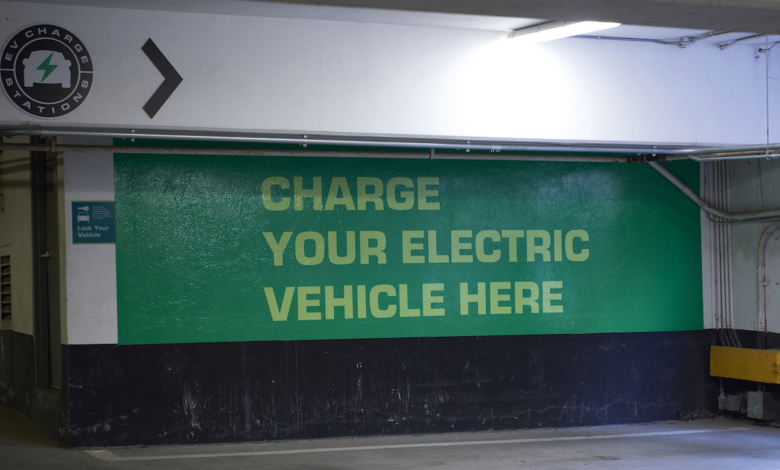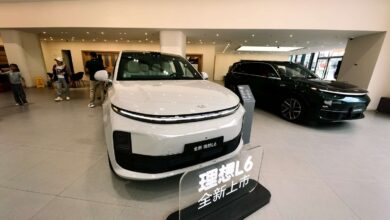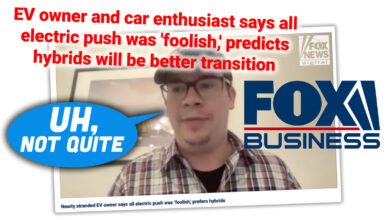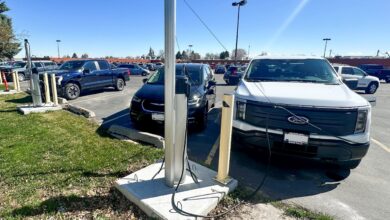What would it take for electric vehicles to help power Ontario’s grid?

Electric-vehicle charging stations are pictured in a Green P parking garage in Toronto on July 26, 2023. (Rachel Verbin/CP)
The laws of physics are unambiguous about a lot of things, and here’s one: it takes a lot of energy to move something heavy at high speed. This is why the battery pack on even a mid-range electric car is likely to store enough electricity to power the median Ontario home for not hours, but days. The Ontario Energy Board uses a planning assumption that an average customer in this province will use 750 kilowatt hours of electricity every month, or about 25 kilowatt hours per day. Meanwhile, new EV models frequently have battery packs capable of storing three or four times that daily amount.
For utility planners, the first priority for accommodating electric vehicles in the power grid has been ensuring there will be enough juice to fill them without causing blackouts elsewhere. But as EVs become more capable and start making up more and more of the market, another possibility is being taken more seriously: that EVs could also feed power back onto the grid during times of high demand, easing the need for new power plants and all they entail.
“I think it’s inevitable,” says Shawn Cronkwright, director of reliability assurance at the Independent Electricity System Operator, the provincial agency responsible for coordinating and planning Ontario’s power grid. “There are always questions about the pace … people who have these technologies will be looking to provide services to the grid in some way, because they can monetize it.”
So-called vehicle-to-grid or V2G or “bidirectional charging” concepts have been proposed for more than a decade but have generally received little interest from utilities, as EVs have remained a relatively small part of the overall industry. That may be changing, however. Last week, the provincial government announced $9.5 million for the IESO’s Grid Innovation Fund, with a specific focus on V2G projects.
“We’re trying to foster innovation,” says Cronkwright. “These are technologies that aren’t quite commercial yet, so a lot of this is about gaining understanding.”
Minister of Energy Todd Smith says V2G is just one example of the kind of distributed energy resources the province’s grid will need in the future.
“We want to give people as much choice as possible. We want it to be a benefit to them to make the leap,” Smith told TVO Today on Tuesday, after announcing a $1 billion refurbishment plan for hydroelectric stations in Niagara Falls. “DERs can play a role, as well as big nuclear and big hydro and wind and solar and batter storage — we’re going to need it all.”
The sheer scale of the battery power that will be rolling around Ontario on four wheels in the decades to come is hard to overstate. The Ontario Clean Air Alliance, in a 2021 presentation to the IESO, noted that, if there are 9 million EVs on provincial highways by 2040, they would have the capacity to put 200 gigawatts of power onto the grid, while the province’s current peak electricity demand is less than 30 gigawatts. The OCAA presentation was clear that this is a numerical exercise and not a realistic proposal — but connecting even a fraction of the EV fleet to bidirectional chargers could allow Ontario to, for example, retire its natural-gas power plants.
“It would be great if they would develop a policy, first to allow EV owners to send power back to the grid when it’s needed and to pay them a fair price for it,” says Jack Gibbons of the Clean Air Alliance. “We need more storage, and this has a potentially huge capacity.”
While the province has expressed interest in large-scale battery electric storage projects, getting local municipal support has been more complicated. An additional advantage to V2G storage is that it would be the next best thing to invisible, as far as local politics goes.
Getting from here to there is not going to be easy, however, and it’s not going to happen quickly. Cronkwright says there are three things that would all need to come together.
“It has to physically work, it has to be commercially viable, and then you have to have a regulatory environment,” Cronkwright says. “It doesn’t have to incentivize it, but it can’t disincentivize it either.”
What commercial viability looks like is an open question. EV owners might be reluctant to let utilities have what amounts to a remote control for their car batteries even if the program were voluntary and came with some kind of incentive. Then there’s the question of how generous the incentive should be. Absent tax dollars being used, any incentive for EV owners would come from electricity prices themselves, potentially raising costs overall, unless V2G adoption allowed Ontario to avoid larger costs elsewhere in the system.
On that score, Cronkwright says there are alternatives to paying EV owners very generously.
“In some of our conservation programs, we’ve learned that you can get really broad adoption even if the dollars aren’t that big,” he says, pointing in particular to the “Peak Perks” program, launched last year, which leverages existing smart thermostats in Ontario homes.
“We take a lot from that,” Cronkwright says. “This most recent thermostat example — it’s just easy. So it might not need some crazy technological advancement; it might just be repackaging something that already exists.”
Gibbons warns that the march of technology isn’t inevitable: the provincial government would need to legalize some form of V2G program for it to take off here, and he’s skeptical that the Ford government will commit to one.
“No one is going to install bidirectional chargers unless our utilities allow people to sell electricity back to the grid and they’re fairly compensated for doing so,” Gibbons said. “If the government of Ontario wants to be really pig-headed, they can frustrate the development of bidirectional charging in Ontario.”
While the Ford government has generously subsidized EV manufacturers for locating production plants in Ontario, it has faced persistent criticism for not subsidizing the purchase of EVs by Ontario consumers. Smith, for his part, denied that a still-hypothetical V2G incentive would be an answer to the government’s critics.
“I think the biggest incentive we can provide the people of Ontario is ensuring we keep electricity affordable,” Smith says. “And that’s what we aim at doing.”



![We played ‘cops and robbers’ in Chevy’s Police Blazer EV [Video] We played ‘cops and robbers’ in Chevy’s Police Blazer EV [Video]](https://europeantech.news/wp-content/uploads/2024/05/1715969918_Blazer-police-EV-vehicles-390x220.jpg)